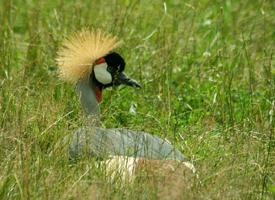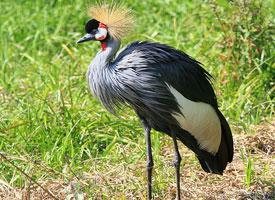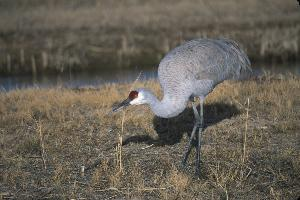
Poids et mesures
| Hauteur au garrot | 1 m |
|---|---|
| Poids | 3,5 kg |
Données biologiques
| Durée de vie | 22 r |
|---|
Description de l'animal
The Grey Crowned Crane (Balearica regulorum) is a captivating bird, celebrated for its striking appearance and graceful demeanor, making it one of the most visually appealing species within the crane family. This elegant bird is indigenous to the eastern and southern regions of Africa, thriving in wetlands, agricultural fields, and even grasslands, showcasing its adaptable nature. The species is distinguished by its impressive height, standing up to about 1 meter (3.3 feet) tall, and weighing between 3.5 to 4 kilograms (7.7 to 8.8 pounds), with a wingspan that can extend up to 2 meters (6.5 feet), allowing it to soar gracefully across the skies.The most distinctive feature of the Grey Crowned Crane is its elaborate plumage. The body is primarily a soft grey, while the wings are predominantly white with a scattering of gold feathers, creating a stunning contrast. The tail feathers are darker, and during flight, the large, broad wings display a magnificent range of colors. However, what truly sets this species apart is its namesake crown of stiff, golden feathers that fan out behind its head, creating a halo effect that is both regal and captivating.
Another striking feature is its face, marked by striking white cheeks and a bright red inflatable throat pouch, which is particularly prominent in males, especially during their elaborate courtship dances. They also possess a distinctive black forehead, contrasting sharply with the bright white patches above and below the eye, giving them a somewhat masked appearance.
Grey Crowned Cranes are omnivorous, feeding on a diet that includes plants, seeds, grains, insects, frogs, and worms. This varied diet helps them thrive in diverse habitats, from dry savannahs to marshes. They are often found near water bodies, reflecting their preference for wetland habitats, which are crucial for their nesting sites.
One of the most remarkable aspects of the Grey Crowned Crane is its mating dance, a spectacle of elegance and complexity. These dances involve jumping, bowing, running, wing flapping, and loud calls that resonate across their habitat. Such displays are not only limited to courtship but are also a means of strengthening bonds between mates, who are monogamous and mate for life.
The breeding season sees these cranes constructing large nests in wetland areas, where they lay a clutch of 2-5 eggs. Both parents are actively involved in the incubation process, which lasts about 30 days. The chicks are precocial, born with their eyes open and covered in down, ready to leave the nest within a few days under the watchful guidance of their parents.
Despite their beauty and the joy they bring to their observers, Grey Crowned Cranes face significant threats from habitat destruction, especially due to the drainage of wetlands, increased agriculture, and urbanization. They are also at risk from illegal pet trade and collisions with power lines. Currently listed as an endangered species, concerted efforts are required to ensure their preservation, including habitat protection and anti-poaching measures.
In summary, the Grey Crowned Crane is a symbol of grace and beauty, embodying the rich biodiversity of the African continent. Its presence enhances the natural landscapes it inhabits, making it a crucial species for conservation efforts to protect the intricate ecosystems of Africa.
Animaux similaires
Nouvelles photos d'animaux
Top 10 des animaux
- Dolphin gull (Leucophaeus scoresbii)
- Diana monkey (Cercopithecus diana)
- Moustached guenon (Cercopithecus cephus)
- Galápagos tortoise (Geochelone nigra complex)
- Japanese macaque (Macaca fuscata)
- Stone loach (Barbatula barbatula)
- Russian tortoise (Testudo horsfieldii)
- Greek tortoise (Testudo graeca)
- Common flying dragon (Draco volans)
- Vendace (Coregonus albula)


